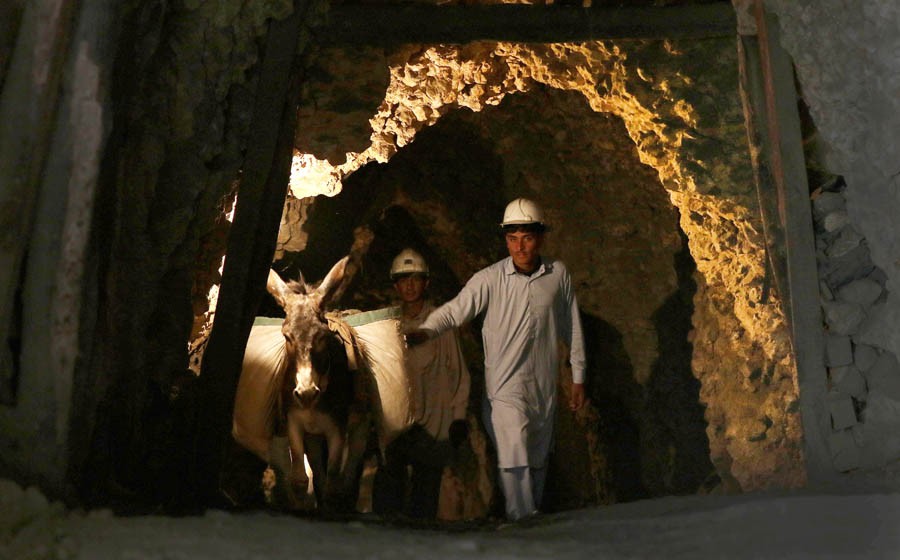
Strict measures to be taken and existing laws implemented...

Two crewmen of a rescue team from Choa Saidan Shah are assessing the level of gases in a coalmine in Dalwal village. They are carrying different equipment to gauge the available oxygen levels some 1000 metres deep in a cave. These crewmen are part of the seven-member team in the area which has many coalmines, employing hundreds of workers.
The rescuers share their experiences, saying they have to go through difficult situations in rescuing trapped workers most of the time. The problems mainly include vehicles in poor condition, limited manpower and equipment of low quality.
The department of Inspectorate of Mines is responsible not only to provide equipment, conveyance, and training to crewmen but also to ensure safety and regulation of mines, including health and welfare of mine workers under the provisions of the Mines Act, 1923.
Mines Labour Welfare Organisation, union of mine workers, is directly responsible for safety and health assurance of mine workers. Both Inspectorate of Mines and Mines Labour Welfare Organisation are wings of Mines & Minerals Department but with different functions.
The Mines Labour Welfare Organisation is responsible for the provision of healthcare, education, housing and other welfare facilities for mine workers and their families through collection of excise duty under the Labour Welfare Act, 1967.
Chapter 5 of the Mines Act, 1923 is about safety and health provisions. Section 18 of the chapter stresses that at each mine the concerned authority must ensure quick supply of ambulances, stretchers, bandages and other medical requirements as may be prescribed. Besides, section 18-A applies on owners or contractors. It states that workers shall be provided first-aid rooms with equipment and medical or nursing staff.
Chaudhry Naseem, President Pakistan Workers Federation, Punjab Chapter, expresses discontentment on the implementation of laws. "Even though the present laws are not updated but, unfortunately, even these laws are not implemented."
Section 20 of the chapter describes the types of accidents and causes, injuries or fatalities. The section elaborates how to inspect the mine after any serious accident and conduct an inquiry.
"Both the government departments and owners of the mines are equally responsible for not taking safety and health measures to make coalmines a safer place for workers," says Naseem. "Penalties for safety violations are ridiculous. The maximum penalty for not ensuring safety of the workers under section 39 and 40 of the Mines Act 1923 is Rs4000 and minimum is Rs5. One year’s imprisonment is also part of the penalty but we never heard anyone was ever punished with such a sentence."
Recommendations have been submitted several times to different provincial and federal governments to introduce amendments in the current law of safety and health of mine workers.
Secretary General Mines and Gypsum Quarries Union, Pind Dadan Khan, Yousaf Naz, believes the main reason behind non-implementation of safety laws is the owners’ influence over government officials. "The concerned department does not want the window of corruption to be closed forever," he says talking to TNS.
"There is no provision in the law to bound owners or contractors to train the workforce to adopt safety and health measures during work. Many accidents happen because of negligence and ignorance of workers about safety measures," Naz adds.
The obligation of implementing these regulations, doing explorations, and mineral development and safety concerns are the domain of the federal and provincial governments.
As per the National Mineral Policy 2013, the ownership of minerals, other than nuclear minerals and those occurring in special areas (ex-FATA, Islamabad Capital Territory (ICT) and International Offshore Water Territory (IOWT)), is a provincial subject under the Constitution.
Khyber Pakhtunkhwa was the first to introduce mineral policy in 2014. The rules put obligation on the owners, mining lessees, and mining officials to regularly conduct medical check-up of mine workers as they are prone to respiratory diseases, including lung cancer. Likewise, inadequacies of mine labour welfare facilities are a major concern. The mineral policy empowers the Chief Inspector of Mines to ensure worker safety under the Mines Act 1923 and keep track of health and safety violations on a mining site.
"Unfortunately, nothing has been implemented on the ground. We have seen serious injuries and casualties, more in KP since the mineral policy was introduced because no one bothers to increase the number of inspectors, rescue members, health facilities, and trained and qualified staff with the latest equipment," Naseem laments.
The Cabinet Committee of the Punjab Assembly has approved the draft to amend the Factories Act 1934 to ensure safety and improve health conditions at the workplace. Nevertheless, a chapter about the coalmines safety has been omitted by the committee. The same approach was adopted by the Sindh Government while approving Sindh Act 2016.
Zahoor Awan, member of International Labour Organization’s governing body and International Trade Union Confederation (ITUC) considers governments’ policy to not include provision regarding mine workers in the above-mentioned acts as a common approach. "Though labour laws in Pakistan are far better than in any other country in South Asia, implementation has always been a serious concern. Mines Act 1923 is still applicable regarding safety and health issues but some improvements are obligatory to be introduced," says Awan says while talking to TNS.
Also read: Editorial
"Different organisations working for the safety and health issues of coalmine workers have given suggestions to different governments, such as that mines must be safe to explore, accident report writing must be ensured, penalty on violation should be increased up to Rs0.5 million with imprisonment, and capacity of inspection teams must be enhanced, etc."
Chaudhry Naseem believes that a separate Department of Safety and Health as per international standards will be very useful. "Highly trained people equipped with latest technology and skills should be employed in such a department. Inspection teams must be a part of this department."